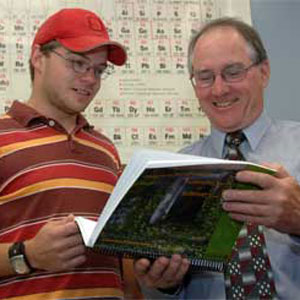 |
| Dr. Jim Pincock shows off the new textbook to student Darren MacLean (Abriel photos) |
"First year is where you get your future chemists from," says James Pincock, Chair of the department. "But our numbers were dropping off in second year. We decided to revitalize the first-year program to try and create the best possible experience."
The synthesis of their efforts is having an impact on the more than 1,000 students enrolled in CHEM 1011, CHEM 1021 and the Dalhousie Integrated Science Program (DISP) this semester. Core courses have been totally reconfigured: from the professors who teach it, the textbooks they use, the homework they assign and the support networks in place for students.
For one thing, instead of sessional lecturers, the job for teaching first-year classes has been given to the some of the department's best teachers Ñ Professors Neil Burford, Norm Schepp, Kevin Grundy, James Pincock, Robert Guy, Mark Stradiotto and instructor Patricia Laws.
But even though the classroom teaching falls to only seven people, the full faculty will participate in marking all tests and examinations. This system provides a return time of one day and immediate feedback for students.
Perhaps the biggest change is the new textbook, Concepts in Chemistry: Structure and Reactivity. This was another pitch-in project, with 25 writers within the department each taking on a topic.
A second volume, Concepts in Chemistry: Energy and Equilibrium, is underway for second term.
"About 18 months ago, Neil (Burford) proposed writing our own textbook. We could focus on material we wanted to present instead of relying on what was in these huge commercial books," explained Dr. Pincock. "The books were in fact so massive that students didn't even use them that much. They were just too heavy to lug around."
The new, two-volume textbook replaces expensive textbooks and manuals that put a $175-dent in a student's Kraft-Dinner budget. Concepts in Chemistry is cheaper and will still make a profit. Those profits go right back to the department.
Concepts in Chemistry is much more than a textbook. Students can write notes and complete exercises beside each lesson. And, for professors, lessons have been converted to Power Point for use in the classroom.
The book is also tied to WebCT. More than 80 movie files have been created to illustrate concepts taught in class. If students missed something in class or are having trouble understanding, they can review the material as often as they need to.
Even so, the online-tutoring vignettes aren't meant to replace one-on-one time with professors. To encourage interaction, the department has set up a comfortable resource centre in the Chemistry building. This is where tutorial groups are run and professors spend their office hours.
"Let's face it, students find it frustrating and sometimes intimidating to find their professor in their office and ask questions," says Patricia Laws. "So our solution was, let's bring the professors to them."
